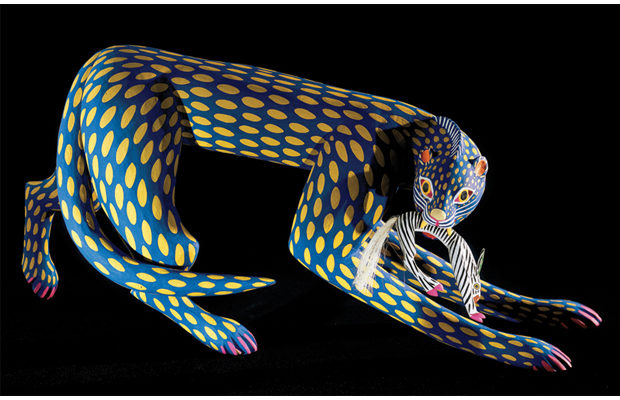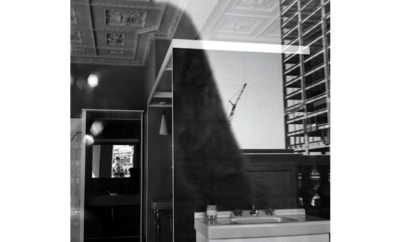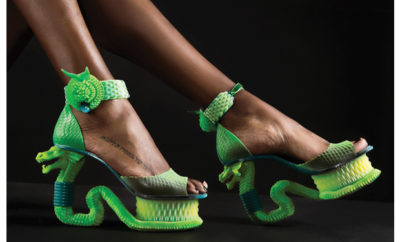
Feature
Magic Realism
Contemporary Latin-American Design Acquires a Global Perspective

MAD’s New Territories exhibition examines several trends in contemporary Latin-American art including artists who work in traditional handcrafts, among them Venezuela’s Mária Antonia Godigna and Anabella Georgi of MáximaDuda, whose woven Moriche palm Miss Delta Amacuro chair dates from 2006.
In his essay “Against Latin American Art,” Cuban critic Gerardo Mosquera discusses the risk of categorizing Latin American artists with absolute labels and superficial stereotypes such as indigenous or colorful. In an enormous and heterogeneous territory, art has often been dismissed with little regard for the historical and cultural distinctions between countries with hugely dissimilar cultures—Cuba and Argentina, for example—that cannot be put into the same mold.
Over the last decade, however, this limited viewpoint—one constructed by the Anglo-American world—has evolved dramatically. And two new exhibitions—New Territories: Laboratories for Design, Craft and Art in Latin America, presented by the Museum of Arts and Design in New York, and Grandes Maestros: Great Masters of Iberoamérican Folk Art, Collection of Fomento Cultural Banamex, at the Natural History Museum of Los Angeles—constitute an important effort in the exploration of the complex nature of contemporary art and design in Latin America.
Recent political and economic improvements in Colombia, Mexico, and Brazil, especially, have witnessed the rise of a new generation of creators, curators, and collectors who are transforming the ways in which art and design are produced in Latin America, and how they are perceived and transacted— the evolution from a domestic practice to a global perspective. Demographic shifts, social improvements, and political stability have fostered the rise of a new middle class (with higher education and purchasing standards) whose members are entering their local markets as collectors for the first time.
At the same time a wide range of emerging artists is embracing new ways of expression, going beyond the modernist focus on conceptualism and political commentary. Artists and designers are repurposing traditional craft and design techniques and reinterpreting the work of native communities through a contemporary lens. That is why ceramics, jewelry, wood, natural fibers, and metal merge together to create a particular aesthetic that reflects the reality of a region larger than a continent that is expanding and connecting with the global society, but at the same time is struggling to keep some of its most valuable traditions alive.

Brothers Silvano Aguirre Tejeda and Francisco Aguirre Tejada of Jalisco, Mexico, create carved and inlaid wooden objects, such as the chest-on-cabinet, 2000.
As a consequence of this internationalization, contemporary Latin American art is attracting a broader audience, which has encouraged American museums to expand their collections and exhibitions of this material. In the summer of 2014 in New York City alone, for instance, we saw Lygia Clark: The Abandonment of Art, 1948 to 1988 at the Museum of Modern Art; Waterweavers: The River in Contemporary Colombian Visual and Material Culture at the Bard Graduate Center Gallery; and Under the Same Sun: Art from Latin America Today at the Solomon R. Guggenheim Museum.

Grandes Maestros: Great Masters of Iberoamérican Folk Art, Collection of Fomento Cultural Banamex at the Natural History Museum of Los Angeles includes Feline, 2001, by Manuel Jiménez Ramirez, who was a Mexican wood carver, painter, and sculptor credited as the originator of the wooden Oaxacan version of alebrijes, or animal creatures.
Now comes MAD’s New Territories: Laboratories for Design, Craft and Art in Latin America, which explores the complexities of contemporary visual expressions in Central and South America. The curatorial program divides the region into urban hubs designated as highly relevant contemporary laboratories for design, craft, and art—Mexico City and Oaxaca in Mexico; Caracas in Venezuela; São Paulo and Rio de Janeiro in Brazil; Santiago in Chile; Buenos Aires in Argentina; San Salvador in El Salvador; San Juan in Puerto Rico; and Havana in Cuba. “The intersection of design, craft and art that can be observed in these hubs represents what the Italian designer Gaetano Pesce has described as a “‘new territory’ in contemporary creativity,” writes MAD’s chief curator Lowery Stokes Sims in the exhibition catalogue.

Caracas, Venezuela, artist Rolando Peña’s chosen theme is oil, represented in his Double Seat Barrel made from an oil drum, 2013–2014. “As an artist, I’m committed to creating awareness, denouncing the ecological disasters caused by oil’s misuse,” he says.
Each hub is analyzed in terms of a particular topic, from urban space to repurposing materials to political displacement. More than seventy-five contemporary artists and designers who transcend traditional barriers and have demonstrated how local practices can be incorporated into a global sphere are represented. The show also looks at how collaborations among small manufacturing operations and craftspeople, artists, and designers have addressed issues not only of commodification and production, but also of urbanization, displacement, and sustainability. Among its key themes, says Sims, are the “dialogue between contemporary trends and artistic legacies in Latin American art; the use of repurposed materials in strategies of upcycling; the blending of digital and traditional skills; and the reclamation of personal and public space.”

Mexican artist Edgar Orlaineta focuses on the minutiae of daily life and transforms existing objects into sculpture, as in Totem after Ettore Sottsass, 2013. “I reconfigure modernist design, architecture, and historical and cultural symbolism into hybrid forms, in which modernist ideals and cultural perspectives collide.
In Los Angeles, Grandes Maestros: Great Masters of Iberoamérican Folk Art, Collection of Fomento Cultural Banamex, signifies an enormous effort to display the intricate reality of contemporary art and design in Latin America, showcasing more than eight hundred works made by six hundred artists from twenty-two countries. “These contemporary artworks stem from long and rich traditions reaching back to the pre-Columbian era and also illustrate European influences,” says Jane Pisano, president and director of the Natural History Museum of Los Angeles. “The creativity of regional contemporary artisans is highlighted in their reinterpretation of longstanding traditions, as well as in creating new ones.”
The exhibition comprises works made by living artists; some are well known, while others are getting their first recognition. Artworks included represent a broad range of mediums, such as clay, wood, plant fibers, paper, leather, textiles, silver, shell, glass, and stones. “What’s exciting about Grandes Maestros is twofold,” Pisano says. “These are contemporary objects that paradoxically represent complex cultural traditions hand-crafted by leading artists from countries that are important to L.A.—countries we visit, do business with, and to which, in many cases, we trace our ancestry.”

Los Angeles-based Chilean Guillermo Bert says, “I first noticed that QR codes, like those used to tag airport luggage, share remarkable similarities to the textiles of the Mapuche peoples of my home country in Chile.” Redemption, 2012, woven by Anita Paillamil, is part of his current series, Encoded Textiles.
In her 2001 book Twentieth-Century Art of Latin America, Jacqueline Barnitz discussed some of the conceptual contradictions in the practice of art in Latin America. For instance, “identity” and “appropriation” are both embraced and sometimes used simultaneously by artists throughout the continent, for example Mexican muralist Diego Rivera, a pioneer of the “identity” theory who worked with his wife Frida Kahlo, an enthusiastic promoter of European expressionism and surrealism. It is this level of complexity and contradiction that characterizes the art produced in Latin America. And that is why exhibitions such as New Territories and Grandes Maestros represent an important contribution to understanding the ways in which artists there are expressing the beauty and reality of a heterogeneous region inhabited by more than 600 million people.

Carlos Rosario Aranguren Rodríguez of Venezuela carves and polishes ebony to form his 2011 Frog.












